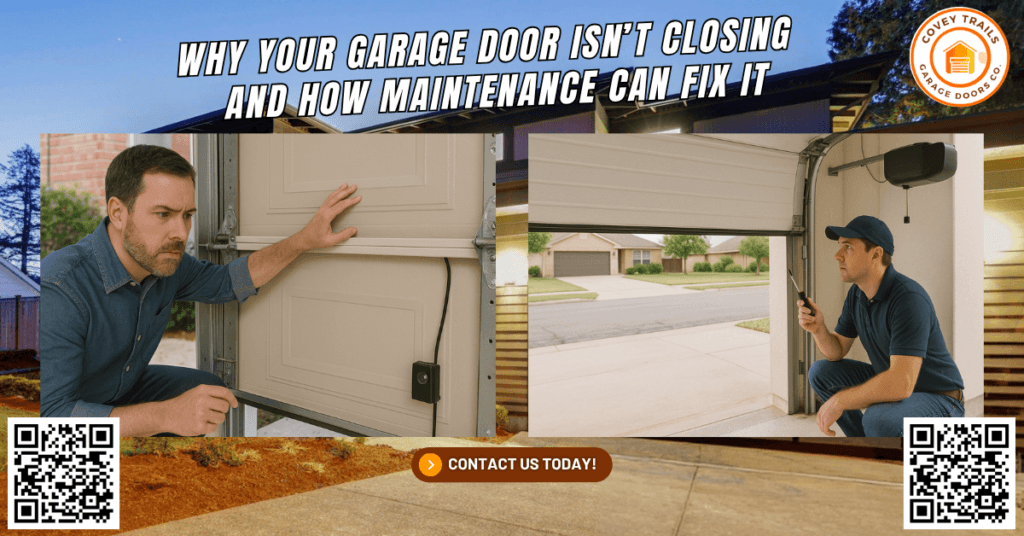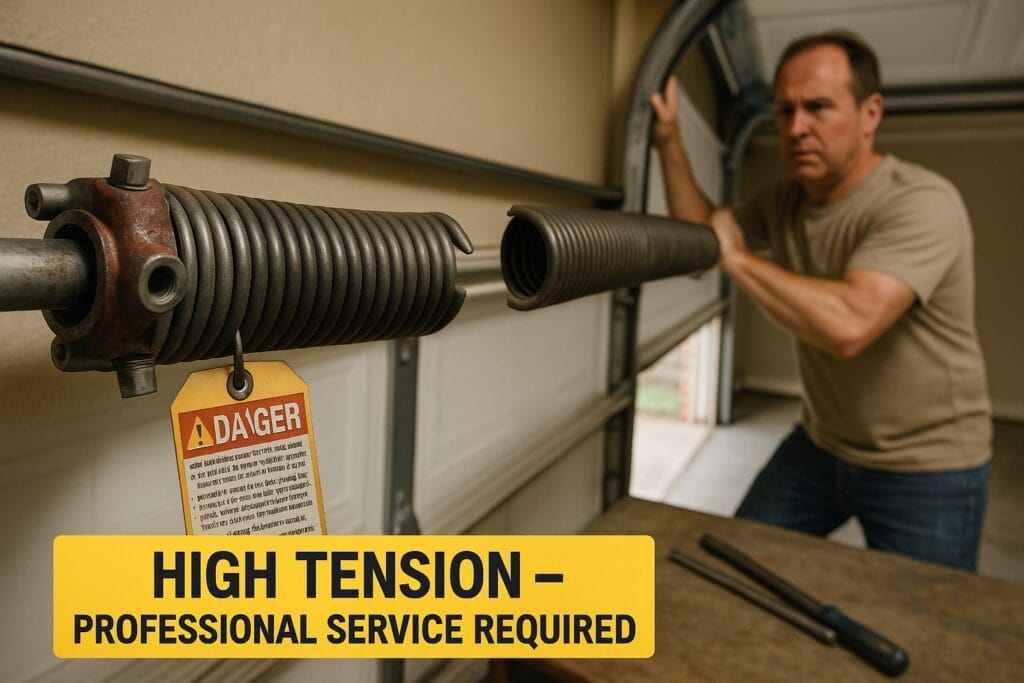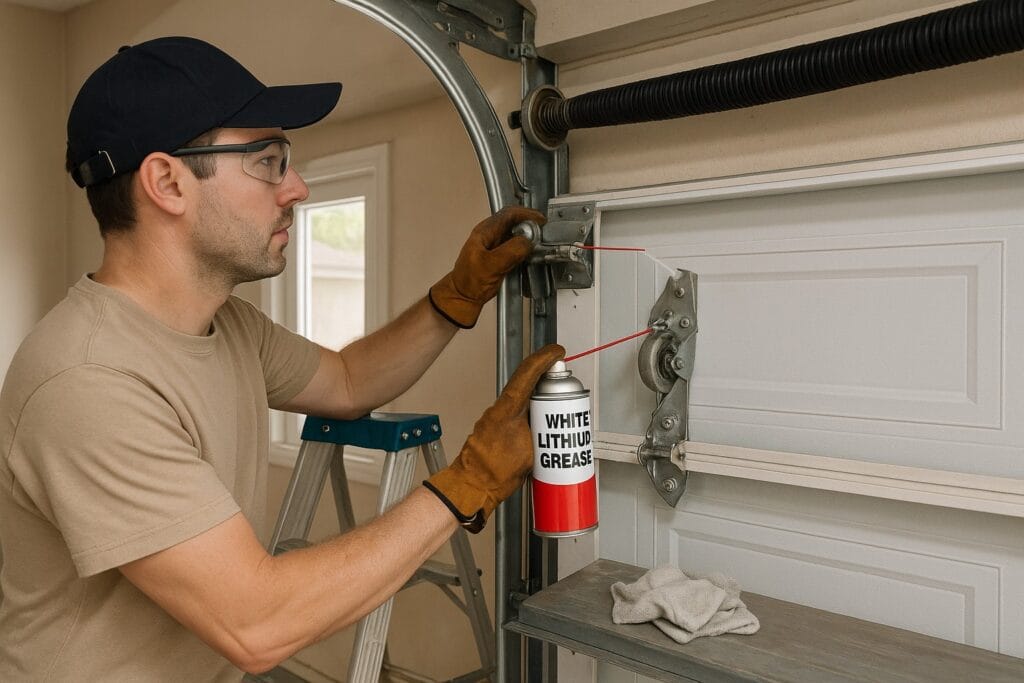Why Your Garage Door Isn’t Closing — And How Maintenance Can Fix It

Imagine rushing home after work, your kids waiting for you inside, and all you want to do is park your car in the garage and relax. But when you hit the garage door opener, nothing happens. Or worse, the garage door starts to close and immediately springs back up. At Covey Trails Garage Doors Co., we’ve seen this scenario play out many times across Richmond, TX. One family had their garage door stuck open during a heavy rainstorm due to a misaligned sensor, leaving their belongings exposed to water damage. Fortunately, a quick fix involving a realignment and full garage door maintenance service got them back on track in no time.
Statistics from industry sources like the Family Handyman and the U.S. Consumer Product Safety Commission show that thousands of people experience garage door malfunctions every year. These issues often arise from neglecting basic maintenance tasks like lubricating metal parts or inspecting torsion springs. If you’re wondering why your garage door isn’t closing properly, the first step is understanding the common causes and how regular upkeep can prevent them. These simple tasks, when done consistently, can help extend the life of your garage door system and prevent costly repairs in the future.
This article is your complete, step-by-step guide to identifying garage door problems and learning how garage door maintenance can restore safe and smooth operation. Whether you have a residential wood door or a steel commercial one, this DIY guide and professional advice can help keep your family and property secure. From opener malfunctions to spring failures, we cover everything you need to know to keep your garage door running like new.
Blocked or Misaligned Safety Sensors
One of the most common reasons garage doors won’t close is due to blocked or misaligned safety sensors. These sensors are part of your garage door’s built-in safety features that prevent it from closing on objects, pets, or people. Positioned near the bottom of the door tracks, they emit an invisible beam. If that beam is interrupted, the door will stop closing and reverse direction.
Dust, debris, or even cobwebs can interfere with the sensors. Misalignment can occur if a roller or track takes a hit or shifts due to regular use. Regular garage door maintenance includes cleaning the lenses with a soft cloth and ensuring both units are aligned at the same angle. Check the LED lights on each sensor; if they are blinking, that’s a sign they are not properly aligned. Adjust the brackets or tighten the bolts until the lights shine steadily. Keeping these sensors clean and functional is crucial for the safety of your home and family.
Broken Garage Door Springs
Another major culprit behind a non-closing door is broken torsion springs or extension springs. These springs bear the entire weight of your garage door during operation. Over time, metal fatigue or rust spots can cause them to snap, rendering your door inoperable. Without the support of functioning springs, your opener may struggle or fail entirely to move the door.

Signs of a broken spring include loud bangs, visible gaps in the coil, or the door feeling too heavy to lift. Replacing garage door springs is not a DIY-friendly task. These parts are under extreme tension and can cause serious injury if not handled properly. Regular maintenance includes inspecting for wear and applying white lithium grease to prevent corrosion and reduce friction. Our expert technicians use proper tools like a socket wrench to safely replace or adjust springs, ensuring your system runs safely and efficiently for years to come.
Malfunctioning Garage Door Opener
If your garage door won’t close but the opener runs, the issue could lie with the garage door opener itself. The automatic opener may be experiencing electrical issues, damaged gears, or problems with the internal logic board. Some advanced openers, such as the Stealth Drive Connect, offer quiet operation but require periodic updates and checks to stay fully functional.
First, inspect the power source. Make sure the unit is plugged in and receiving electricity. Next, test the remote and wall switch; replace batteries or reprogram them if needed. Openers often include an auto-reverse feature and limit settings that control the distance the door travels. Adjusting these settings with a screwdriver may resolve inconsistencies. If the issue persists, the opener’s motor, sensors, or wiring may need professional diagnostics and repair to restore reliable performance.
Track Obstructions or Damage
The garage door tracks guide the door during opening and closing. Bent or blocked tracks can prevent smooth operation. Common causes of track problems include accidental bumps from vehicles, debris buildup, or loose bolts. Damage to the roller brackets or track misalignment can strain the entire door system and eventually lead to system failure.
Maintenance for tracks includes inspecting them multiple times a year for dents, rust, and debris. Clean them using a vacuum and a damp cloth to remove buildup. Apply a spray lubricant or garage door lubricant to the metal parts, focusing on the rollers, hinges, and bearings. Ensure all bolts and fasteners are tightened with a wrench to keep the tracks aligned. If a track appears significantly bent or twisted, it should be repaired or replaced immediately to prevent further damage to your garage door parts.
Limit Settings on the Opener
Every garage door opener includes limit switches that control how far the door travels in either direction. If the door closes partway and then reverses, it may be due to incorrect limit settings. These settings tell the opener when the door is fully open or closed. If the limit is set too short, the door thinks it’s hitting something and automatically reverses for safety.
Locate the adjustment screws on the side or rear of the opener unit. Using a screwdriver, turn the “close” limit screw clockwise in small increments, testing the door between each adjustment. This step-by-step guide is usually included in your garage door opener manual. Be patient and adjust multiple times if needed. Also, check the opener’s arm bar, top rail, and chain or belt drive system for any structural interference or worn parts that might affect performance.
Remote or Wall Switch Issues
Sometimes, the problem is as simple as a faulty remote or wall-mounted door switch. If pressing the remote doesn’t do anything, start by replacing the batteries. If that doesn’t help, try reprogramming it using the garage door opener manual’s instructions. Wall switches can also malfunction due to worn contacts, frayed wires, or electrical shorts.
Inspect the wall unit for physical damage and test all buttons. You can also test the release handle on the opener to manually operate the door and isolate the issue. If all remote controls stop working at once, the opener’s logic board may need replacement. Technicians use voltage meters and specialized tools to diagnose and repair these components. Ensuring your remotes and switches are functioning correctly is an essential part of a well-maintained garage door system.
Importance of Garage Door Maintenance
Regular maintenance is the best investment you can make in your garage door system. Just like any mechanical system in your home, your garage door requires attention to ensure safe and smooth operation. Over a year, it may open and close thousands of times, placing stress on springs, rollers, cables, and tracks. Ignoring these parts can lead to avoidable failures and even hazardous situations.

Proper maintenance includes tasks such as lubricating moving parts with white lithium grease, inspecting the weather stripping, cleaning garage door tracks, and tightening nuts and bolts. Performing these tasks can prevent small issues from snowballing into major repairs. Plus, maintenance extends the life of the door and saves you from costly emergency fixes. Don’t wait until the door won’t open; add maintenance tasks to your seasonal home checklist to ensure long-term reliability and safety.
Residential vs. Commercial Garage Door Issues
At Covey Trails Garage Doors Co., we handle both residential garage doors and commercial garage doors, each with unique challenges. Residential systems often prioritize appearance, insulation, and quiet operation. Homeowners want their garage to be a comfortable extension of their home, with garage door openers that integrate with smart home features.
Commercial systems, on the other hand, are built for durability and security. These steel doors are heavier, larger, and used more frequently. The maintenance schedule for commercial systems involves checking cables, torsion springs, metal bearings, and arm bars on a regular basis. Proper weather seals and timely grease applications help commercial systems endure heavy-duty use. Whether you operate a warehouse or a family garage, consistent maintenance ensures that your doors function correctly and keep everyone safe.
DIY Troubleshooting Checklist
Here’s a quick reference chart to help you with common garage door problems before calling a technician:
|
Issue |
DIY Fix |
|
Door won’t close at all |
Clean safety sensors; check for obstructions; inspect tracks |
|
Door closes and then reopens |
Adjust limit settings, realign sensors, and inspect springs |
|
Opener runs, but the door won’t move |
Check torsion springs and power source; inspect gears in opener |
|
Door is noisy or shaky |
Lubricate rollers and hinges; inspect track alignment; tighten bolts |
|
Remote doesn’t work |
Replace batteries; reprogram the remote; test the wall switch |
Use tools like a socket wrench, spray lubricant, and clean cloths for these tasks. If the problem persists, reach out for professional help to avoid damaging the door or injuring yourself. Always disconnect power before performing any electrical checks to ensure safety.
Seasonal Maintenance Tips for Richmond, TX
Richmond’s changing weather patterns can be tough on garage door systems. In spring and summer, humidity and heat can expand metal components, making them rub against each other. In winter, cold weather may cause the lubricant to stiffen or rubber seals to crack. Regular inspection is essential to catch weather-related wear before it becomes serious damage.
During hot months, clean and inspect garage door rollers, ensure the weather stripping is intact, and lubricate metal parts to prevent squeaks and jams. In colder months, inspect torsion springs for brittleness, and make sure your garage door opener’s backup battery is working properly. Also, inspect the sealant around the base of your door to prevent water and debris intrusion. Seasonal garage door maintenance ensures that your system operates reliably in all temperatures, protecting your home and garage year-round.
How Maintenance Saves Money Over Time
Many people overlook preventative maintenance, thinking it’s an unnecessary cost. But keeping your garage door system well-maintained can save you hundreds, if not thousands, of dollars in repair and replacement costs. Neglecting lubrication, alignment, or worn parts can accelerate wear and lead to premature failure.
Replacing a garage door spring in an emergency can cost significantly more than a scheduled maintenance visit. By keeping all garage door parts clean, lubricated, and properly adjusted, you reduce the strain on the system and extend the life of expensive components. Think of it like oil changes for your car, cheap compared to the cost of replacing the engine. Scheduled tune-ups with Covey Trails Garage Doors Co. include inspections, lubrication with the right grease, tension tests, and sensor checks. These steps provide peace of mind and help maintain quiet, reliable operation year-round.
Final Thoughts
A malfunctioning garage door can disrupt your day, compromise your home’s security, and even pose a danger to your family. The good news is that most garage door issues stem from causes that are preventable with routine garage door maintenance. From lubricating hinges and tracks to adjusting sensors and springs, taking the time to maintain your system ensures safe, efficient operation.
Garage doors are complex systems with many moving parts, and neglecting even one component can lead to breakdowns. With regular inspections and timely maintenance, you can extend the lifespan of your garage door, improve safety, and avoid frustrating malfunctions. Your garage is more than just a place to park your car; it’s a critical part of your home’s comfort and security. Make garage door care a regular part of your home maintenance plan.
How Can Covey Trails Garage Doors Co. Help You?
At Covey Trails Garage Doors Co., we specialize in providing reliable garage door service for homes and businesses in Richmond, TX, and surrounding areas. Our team of certified technicians is trained to handle every type of garage door issue, from broken springs to damaged tracks, malfunctioning openers, or complex custom installations.
Here’s what we offer:
- Thorough inspections of your garage door system
- Fast and affordable repairs
- Installation of new garage doors and openers
- Preventative maintenance plans tailored to your needs
- Emergency services for urgent repairs
We serve the community with professionalism, integrity, and a focus on safety. Whether you need a tune-up or emergency repair, you can count on us. We use only high-quality garage door parts and tools to ensure long-lasting results. Our friendly staff is always ready to answer your questions and provide expert advice.
Address: 1093, Richmond, TX 77406, United States
Phone: (713) 401-9063
Give us a call today and schedule your garage door service. Let us help you keep your door moving safely and smoothly, year after year.
Frequently Asked Questions (FAQs)
1. How often should I lubricate the components of my garage door?
It’s recommended to lubricate all moving metal parts like rollers, hinges, and springs at least every six months using a spray garage door lubricant or white lithium grease.
2. Can I reset my garage door opener myself if it’s not responding?
Yes, most garage door openers have a reset button; you can also unplug the unit for 30 seconds and plug it back in to perform a manual reset.
3. What type of maintenance should I avoid doing myself?
Any work involving torsion springs or cables should be left to professionals, as these parts are under high tension and can be dangerous.
4. How do I know when it’s time to replace my garage door instead of repairing it?
If your garage door has structural damage, extensive rust, or has required multiple repairs over the years, it may be more cost-effective to invest in a new one.
